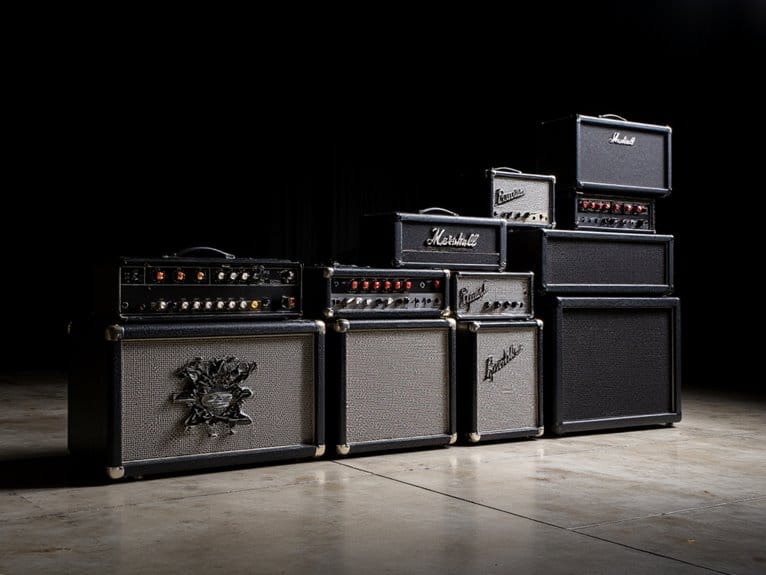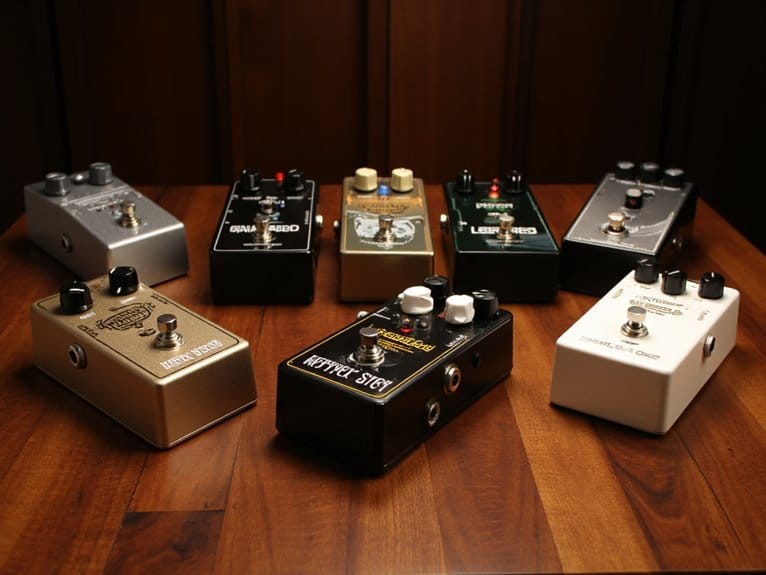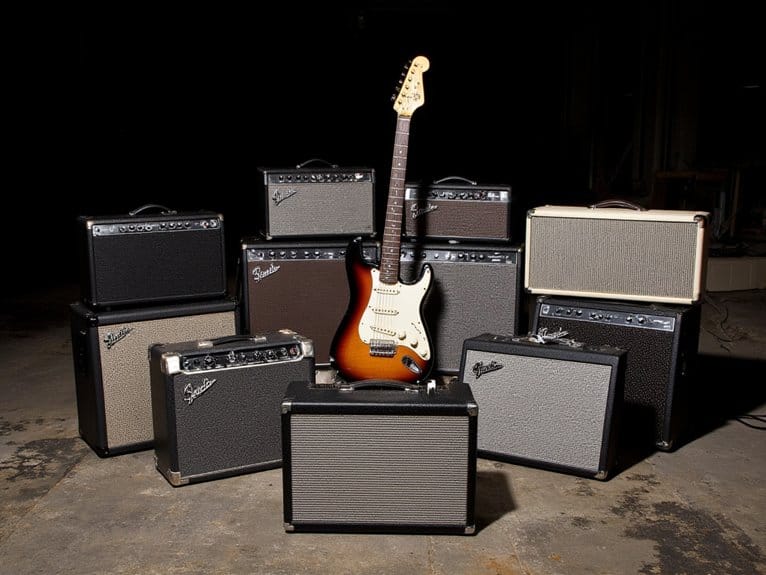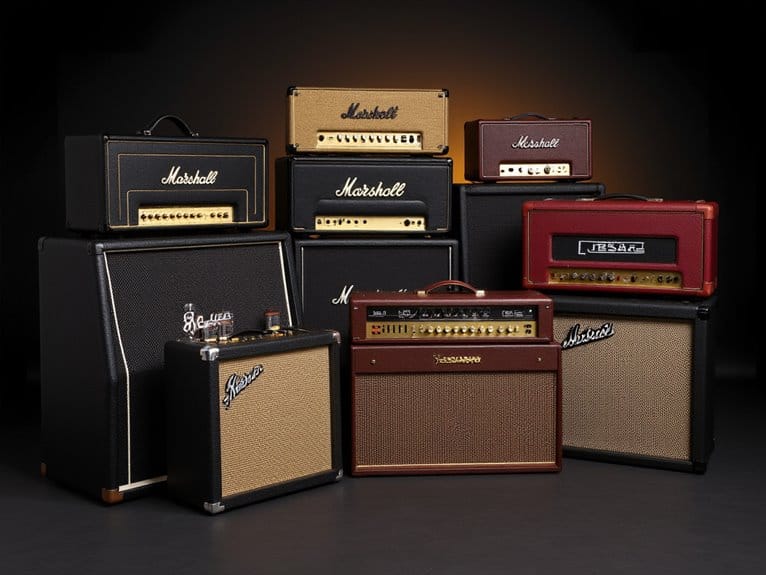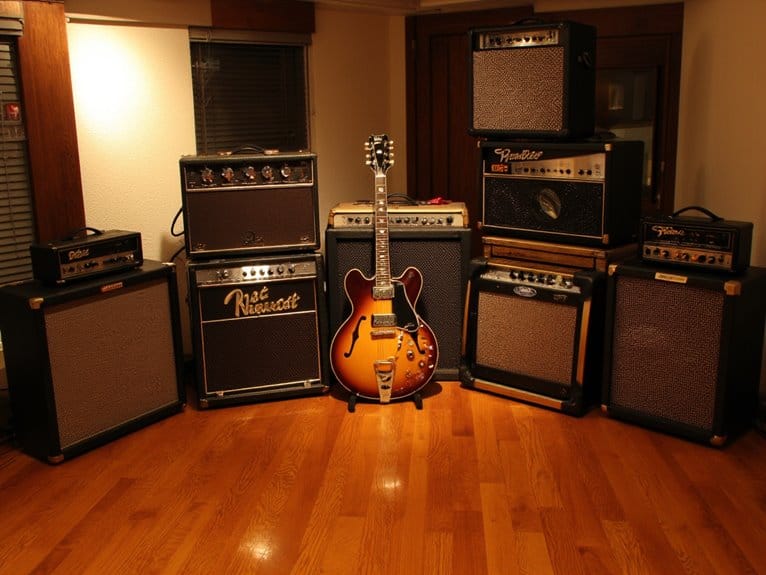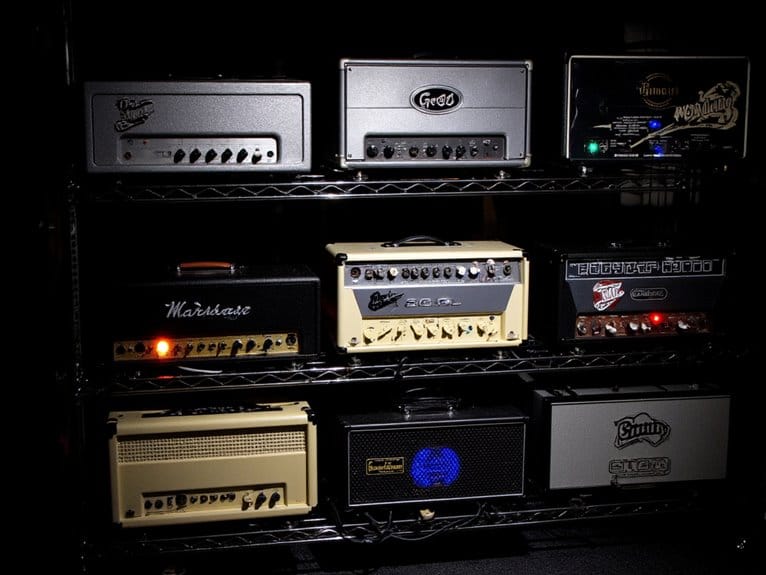Best Small Bass Amps That Deliver Big Sound in a Compact Package
After testing dozens of compact bass amps, I’ve found that models like the JOYO MA-10B and Fender Rumble 15 V3 deliver surprising clarity despite weighing under 20 pounds. The best small amps offer 10-20 watts of power, battery operation for portability, and essential features like headphone outputs and AUX inputs for practice sessions. While compact designs can compromise some sound quality, quality options ranging from $50-150 now provide the punch once requiring massive combo amps, and there’s much more to evaluate when choosing your perfect practice companion.
We are supported by our audience. When you purchase through links on our site, we may earn an affiliate commission, at no extra cost for you. Learn more.
Notable Insights
- JOYO MA-10B and CMA10B offer 10W power output under 3 pounds with battery operation and headphone outputs.
- Fender Rumble 15 V3 delivers 15 watts through 8-inch speaker with 3-band EQ for home and small gigs.
- Look for 10-20 watt amps with AUX inputs and headphone outputs for versatile practice and jamming options.
- Best portable models weigh under 3 pounds with 3-4 hour battery life for easy transport and outdoor use.
- Quality small bass amps range $50-150 with 4.0-4.7 star ratings, balancing portability with sound performance.
JOYO 10W Mini Bass Amp Practice Amplifier (MA-10B)
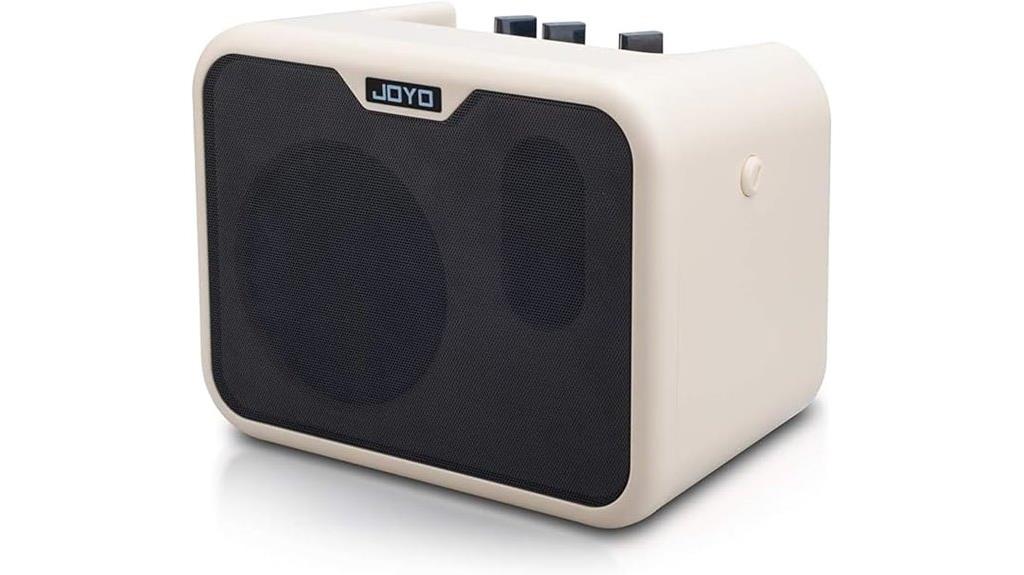
The JOYO MA-10B represents the sweet spot for budget-conscious bassists who need a reliable practice companion without sacrificing essential features, and frankly, I’ve been impressed by how much functionality JOYO managed to pack into this 3-pound powerhouse. You’ll get switchable Normal and Drive channels with proper tone control, plus headphone output for silent practice sessions when your neighbors aren’t feeling your late-night groove. The AUX input lets you jam along with tracks from your phone, while the dual power options—adapter or battery—provide up to three hours of portable playing time that’ll fit neatly in your backpack.
Best For: Budget-conscious bassists who need a portable practice amplifier with essential features like dual channels, headphone output, and battery operation for home practice and outdoor jamming sessions.
Pros:
- Highly portable at under 3 pounds with battery operation providing up to 3 hours of playtime
- Versatile connectivity options including headphone output for silent practice and AUX input for playing along with external audio sources
- Dual channel functionality (Normal/Drive) with tone and gain controls for sound customization at an affordable price point
Cons:
- Limited 10-watt power output may not be sufficient for band practice or small venue performances
- Battery life of only 3 hours may require frequent recharging during extended practice sessions
- As a budget amplifier, it may lack the build quality and advanced features found in higher-end practice amps
Fender Rumble 15 V3 Bass Amp (15 Watts, 6 Inch Speaker)
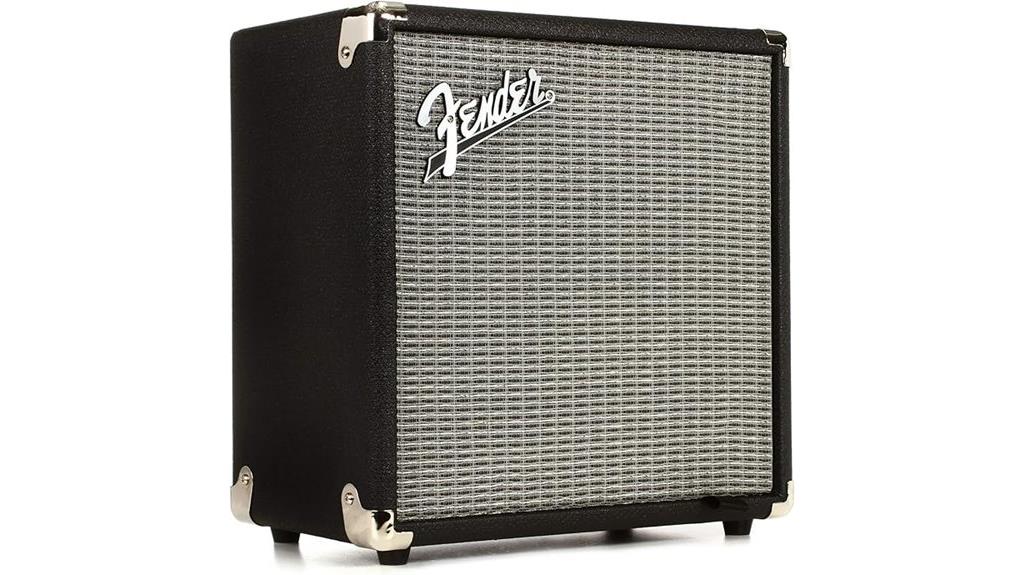
When you’re seeking a reliable practice companion that won’t break your back or your budget, the Fender Rumble 15 V3 Bass Amp delivers an impressive 15 watts of power through its 8-inch Fender Special Design speaker, weighing just 18.6 pounds in a surprisingly compact 17.8 x 12.3 x 17.8-inch sealed enclosure. You’ll appreciate the top-mounted control panel featuring ivory soft-touch knobs, 3-band EQ, overdrive circuit, and mid-scoop contour switch that shape your tone with precision. The 1/8-inch auxiliary input accommodates your MP3 player, while the 1/4-inch headphone output mutes the speaker for silent practice sessions, making this versatile amp suitable for rehearsals and small gigs.
Best For: Bass players seeking a lightweight, portable practice amp for home use, small rehearsals, and intimate gigs who need reliable performance without sacrificing tone quality.
Pros:
- Impressive power-to-weight ratio with 15 watts in an 18.6-pound package that’s easy to transport
- Versatile connectivity options including aux input for backing tracks and headphone output for silent practice
- Comprehensive tone controls with 3-band EQ, overdrive circuit, and mid-scoop contour switch for precise sound shaping
Cons:
- Some users report overheating issues during extended playing sessions
- Limited power may not be sufficient for larger venues or louder band situations
- Small 8-inch speaker may lack the depth and punch needed for more demanding bass applications
STRICH 2 x 5 W Mini Bass Amp – Portable Rechargeable Practice Amplifier
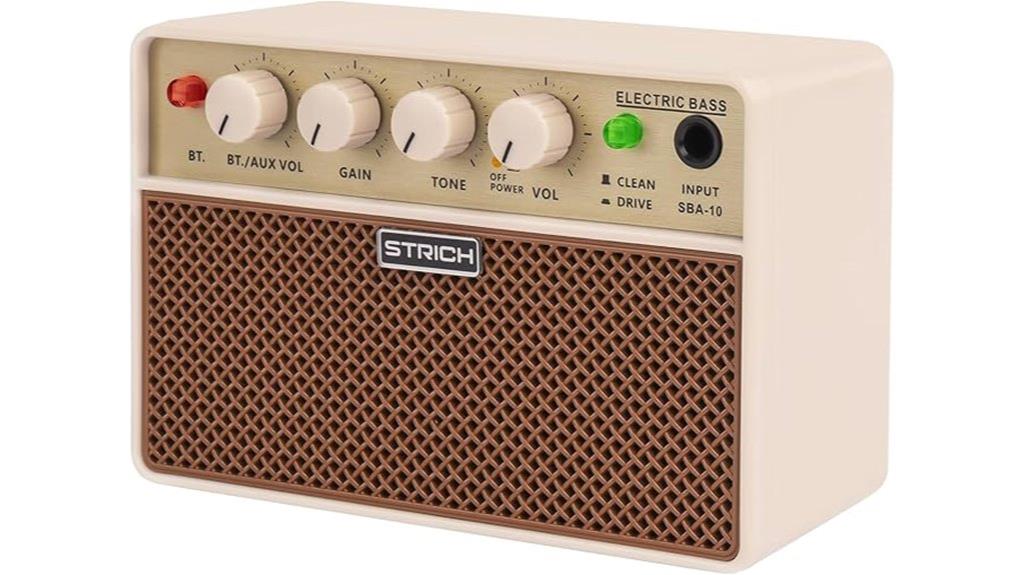
Beginners seeking their first practice amplifier will find the STRICH 2 x 5 W Mini Bass Amp perfectly suited for bedroom sessions, dorm rooms, and coffee shop practice corners where space comes at a premium. At 6.77×3.62×4.96 inches, this desktop-friendly unit houses dual channels—clean and drive—with independent volume controls for Bluetooth and AUX inputs, letting you customize your sound alongside backing tracks. The 3000mAh battery delivers four hours of continuous playing time, while the 1/8-inch headphone output guarantees you won’t disturb roommates during late-night practice sessions. Hard material edges and rubber pads provide stability and protection for this compact powerhouse.
Best For: Beginner bass players who need a compact, portable practice amplifier for small spaces like dorm rooms, bedrooms, or coffee shops where quiet practice options and space efficiency are essential.
Pros:
- Compact desktop-friendly design with 4-hour battery life makes it perfect for portable practice anywhere
- Dual clean and drive channels with independent Bluetooth and AUX volume controls offer versatile sound customization
- Headphone output allows for silent practice without disturbing others, ideal for shared living spaces
Cons:
- Limited 10W total power output may not be sufficient for band practice or small venue performances
- 4-hour battery life requires regular recharging for extended practice sessions
- Compact size may limit overall sound projection and bass response compared to larger amplifiers
Ueteto 10W Mini Bass Amp, Portable and Rechargeable Bass Guitar Practice Amplifier
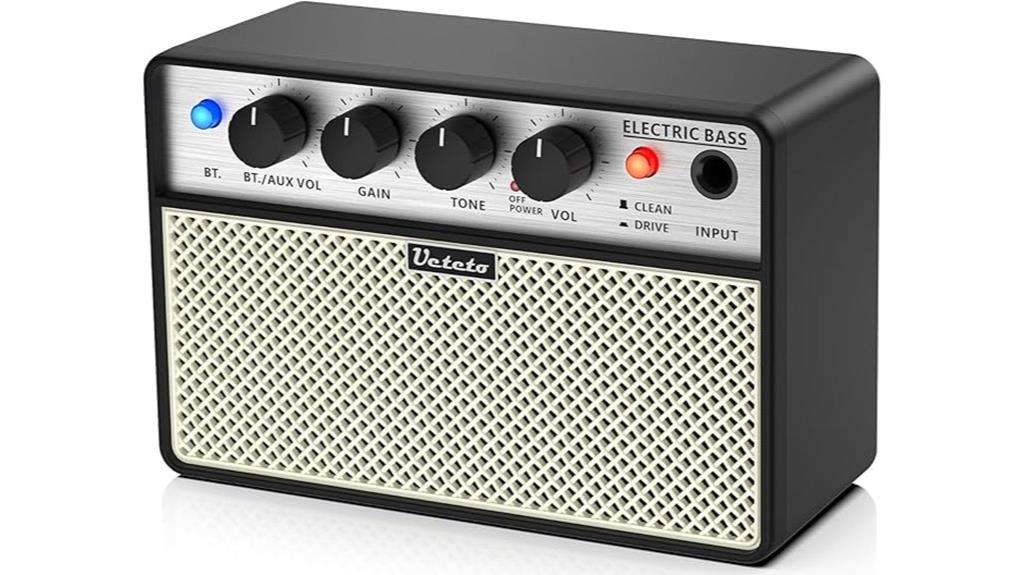
Portable practice sessions become effortless with the Ueteto 10W Mini Bass Amp, which I’ve found delivers surprisingly robust bass tones through its dual 5-watt subwoofer configuration despite weighing less than most textbooks. You’ll appreciate the four-hour battery life during extended practice sessions, while the dual-channel design offers both clean and drive settings for tonal versatility. The independent volume controls for Bluetooth and AUX inputs let you seamlessly blend backing tracks with your bass, and I’ve noticed the headphone output maintains solid low-end response for silent practice. Though it’s designed specifically for bass guitar practice, the compact form factor makes it genuinely portable.
Best For: Bass guitarists who need a compact, portable practice amplifier for home sessions, travel, or anywhere silent practice with headphones is required.
Pros:
- Dual 5-watt subwoofer configuration delivers surprisingly robust bass tones despite compact size
- 4-hour rechargeable battery provides extended practice sessions without needing power outlets
- Independent volume controls for Bluetooth and AUX inputs allow seamless blending of backing tracks
Cons:
- 10W power output may be insufficient for band practice or small venue performances
- Limited to bass guitar use only, lacking versatility for other instruments
- Compact design may compromise speaker size and overall volume compared to full-sized practice amps
GLARRY Electric Bass Combo Amp, 20W Practice Bass Guitar Amplifier
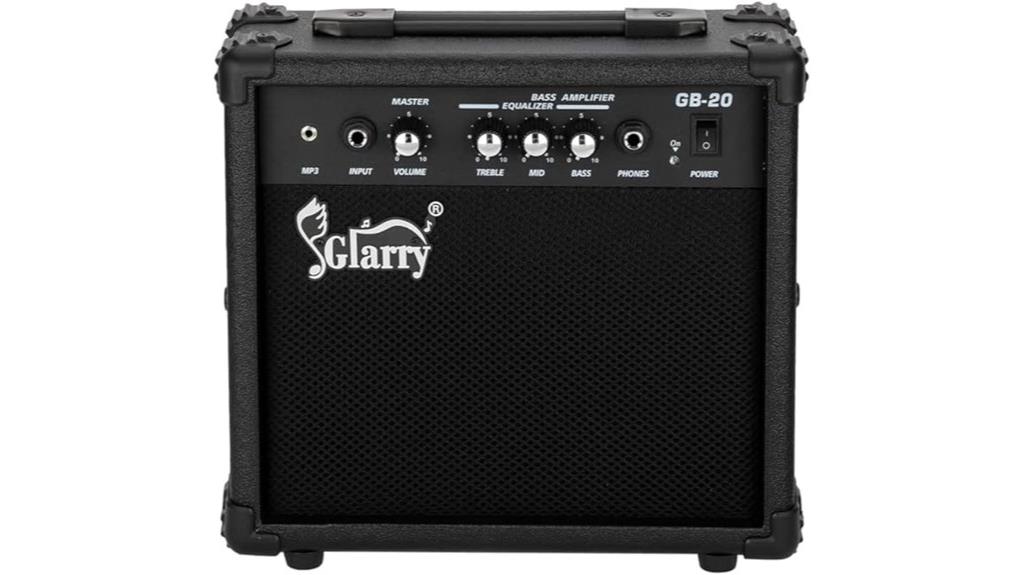
While searching for an affordable practice amp that won’t break the bank or disturb your neighbors, the GLARRY Electric Bass Combo Amp stands out as a solid choice for beginners who need reliable sound reproduction in compact spaces. This 20-watt amplifier delivers surprising versatility through its five-knob control system, which includes gain, volume, treble, bass, and middle adjustments that let you dial in your preferred tone. The 6.5-inch speaker produces adequate sound for personal practice sessions, though you’ll notice some limitations in depth and richness that become apparent during extended playing. Its wood construction with protective rubber edges guarantees durability during transport, while the 1/4-inch headphone output enables silent practice without disturbing roommates or family members.
Best For: Beginner bass players who need an affordable practice amplifier for small spaces and personal use without disturbing others.
Pros:
- Five-knob control system (gain, volume, treble, bass, middle) provides good tonal flexibility for a budget amp
- Headphone output allows for silent practice, perfect for apartments or late-night sessions
- Portable design with protective rubber edges and belt clip makes it easy to transport
Cons:
- Sound lacks depth and richness, producing a somewhat tinny tone quality
- Limited volume output makes it unsuitable for performances or larger spaces
- Not recommended for serious players who need professional-quality sound reproduction
Factors to Consider When Choosing a Small Bass Amp
When I’m helping musicians select the perfect small bass amp, I’ve found that understanding your specific needs across five key areas will save you time, money, and potential buyer’s remorse down the road. The power output you’ll require depends heavily on your intended use case, whether that’s bedroom practice sessions, small venue performances, or recording applications, while portability factors like weight and dimensions become vital if you’re frequently transporting your gear. I’ll walk you through the essential considerations regarding channel configurations, power source options, and connectivity features that’ll help you make an informed decision based on your playing style and performance requirements.
Power and Wattage Requirements
Power output serves as the foundation for any small bass amp purchase, and I’ve found that understanding your specific wattage needs can save you from both underpowering your practice sessions and overspending on unnecessary features. For home practice, I recommend 10-watt amps, which deliver sufficient volume for personal use without overwhelming your neighbors. However, when jamming with other musicians, particularly drummers, you’ll need 15 to 20 watts to cut through the mix effectively. I’ve learned that higher wattage translates to better sound clarity at increased volumes, making those extra watts worthwhile for rehearsals. If you’re constantly moving between practice spaces, consider lightweight options under three pounds, and battery-operated models provide excellent flexibility for outdoor sessions, typically offering three to four hours of playtime.
Portability and Weight Considerations
Since lugging around heavy equipment has taught me the value of truly portable gear, I’ve discovered that the best small bass amps balance lightweight construction with durability, typically weighing under three pounds while maintaining the robust build quality necessary for regular transport. The compact dimensions, usually measuring five to nine inches in height and width, allow these amps to slip into backpacks alongside other essentials without consuming valuable space. I’ve found that battery-powered models offer exceptional convenience, eliminating the frustration of hunting for power outlets during impromptu practice sessions, with quality units providing up to four hours of continuous use. While bulkier amplifiers exceeding fifteen pounds may deliver more power, they quickly become impractical burdens for musicians who prioritize mobility over maximum output.
Channel Options Available
After securing a lightweight amplifier that won’t strain your back during transport, the channel configuration becomes your primary tool for shaping your bass sound, with most quality small amps offering at least two distinct channels that cater to different playing styles and musical situations. I’ve found that Normal/Drive channel switching provides the versatility you’ll need, allowing seamless shifts from clean, punchy tones to warm, driven sounds without external pedals. Each channel typically includes independent volume controls, which I appreciate for balancing different sound profiles during practice sessions. The inclusion of dedicated tone controls—treble, midrange, and bass—across channels lets you fine-tune frequencies for each setting, creating personalized sound experiences that adapt to various musical genres and playing techniques.
Battery Vs Power Options
When choosing between battery-powered and corded operation, I’ve discovered that your intended usage patterns will dictate which power configuration serves you best, as each option brings distinct advantages that align with different practice environments and performance scenarios. Battery-powered units using AA or AAA batteries deliver 2 to 4 hours of playtime, making them ideal for outdoor sessions or situations where outlets aren’t available. I particularly appreciate amps with rechargeable batteries, which eliminate ongoing battery costs while providing 3 to 4 hours of consistent performance. However, I’ve found that dual-power amps offer the best flexibility, allowing me to switch between battery operation for portability and corded power for extended home practice sessions without worrying about power limitations or added weight from battery compartments.
Connectivity and Input Features
Three essential connectivity features can make or break your practice experience with a small bass amp, and I’ve learned through countless sessions that having the right inputs and outputs transforms these compact units from simple amplifiers into versatile practice hubs. Auxiliary inputs prove invaluable for jamming along with tracks from your phone or music player, turning solo practice into interactive sessions that keep me engaged longer. A dedicated headphone output becomes your best friend during late-night practice, delivering full amp tone without disturbing neighbors or family members. Multiple input options, including instrument and line inputs, accommodate different signal sources and practice scenarios, while some amps even feature Bluetooth connectivity for wireless audio streaming from your devices.
Sound Control and EQ
How dramatically can proper EQ controls transform your small bass amp’s sonic potential? I’ve found that tone control options, which allow you to adjust brightness and darkness levels, fundamentally shape your instrument’s character to match personal preferences and venue acoustics. The essential bass, mid, and treble controls enable precise audio output tuning, enhancing sound quality across various music styles, from punchy rock to smooth jazz. Multiple channels, particularly CLEAN and DRIVE settings, provide quick shifts between contrasting tone profiles during performances. Advanced models incorporate gain control, manipulating distortion levels and overall power output to achieve specific sounds for different playing techniques, while headphone outputs for silent practice and AUX inputs maintain sound diversity.
Budget and Value Factors
While sound shaping capabilities can make any small bass amp shine, I’ve learned that your budget ultimately determines which sonic possibilities you’ll actually have access to. Most quality small bass amps fall within the $50 to $150 range, offering competitive pricing that won’t break the bank. I typically recommend setting your budget based on intended use—practice sessions require less investment than performance applications. Power output becomes essential here, as 10 to 20 watts suits practice perfectly but limits venue options. I always check user ratings, looking for models averaging 4.0 to 4.7 stars within my price range. Features like headphone outputs and AUX inputs greatly enhance value, transforming basic practice amps into versatile tools that justify their cost.
On a final note
I’ve tested countless bass amps over the years, and these compact models prove you don’t need a massive rig to get quality sound. Whether you’re practicing in your apartment, jamming with friends, or need a portable solution for small gigs, there’s an option here that’ll work for your budget and needs. Consider your power requirements, connectivity options, and portability needs before making your final decision.

